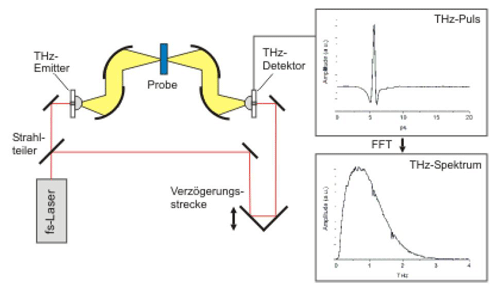Terahertz Technologie
The frequency range of Terahertz (THz) radiation, located between the Microwaves and the Infrared region of the electro-magnetic spectrum has become accessible in an efficient way only within the last few years. Thus, THz-Technology is an area of research with immediate actuality.
An important property of THz-radiation is its large penetration depth for many non-conductive materials, such as plastics, polymers, compound materials, tissues or ceramics. Additionally, many chemical substances exhibit characteristic absorption pattern (fingerprints) at THz-frequencies. Because of its low energy, THz-radiation is non-ionizing, in contrast to X-ray radiation. For these reasons, THz-technology has high potential for noncontact and non-destructive investigation and characterization of materials. THz-Technology comprises the fields THz-Imaging, THz-Spectroscopy (Time-domain Spectroscopy, TDS), and a combination of both (THz-Spectroscopic Imaging, THz-Hyperspectral Imaging).
PrincipleMany THz-systems apply pulsed, broadband THz-radiation and a time-resolved detection scheme. A typical TDS-setup in transmission geometry is shown in the illustrated figure.
For excitation of pulsed THz-radiation a femtosecond (fs) pulse laser is used. Part of the laser beam is focussed onto a THz-emitter (e.g., photoconductive switch). The emitted THz-radiation is focused onto the sample and thereafter impinges onto a THz-detector (e.g., photoconductive switch, electro-optical crystal). For time-resolved detection of the THz-signal, the second part of the laser beam is directed on the detector as well. By translation of a delay line positioned in the optical path of the laser beam the time delay between excitation and detection is varied, such that the THz-pulse is sampled in a time-resolved way.
|
 |
The THz-spectrum is obtained by Fourier transform (FFT) of the time-resolved signal (Fig. 1). Exploiting the information about phase and amplitude, the frequency dependent optical constants (refractive index.html, absorption coefficient) can be directly determined. For THz-Imaging, the sample additionally is scanned laterally and is evaluated (amplitude, time delay, spectral information) and depicted in a locally resolved way. Due to the wavelength of the THz-radiation, the lateral resolution of the THz-ray is in the millimetre range.
Benefit
An example for the application of THz-Imaging for material investigations is the examination of plastics, glass-fibre compound materials or ceramics. Defects or inclusions with sizes in the millimetre-range can be detected, also if the sample appears non-transparent for visible light. In particular when the polarization properties of the THz-radiation are exploited, information about birefringence and consequently about anisotropies or strain inside the material can be obtained – parameters which are difficult to be obtained by other methods. An application is the analysis of the orientation of fibres in GFC materials.
The potential of THz-spectroscopy lies in the detection and analysis of various chemical crystalline substances, such as drugs or explosives. Packaging made from paper or plastics are no obstacle for these measurements, and the sample can be analysed without unpacking. It should be noted that polar substances as e.g. water strongly absorb THz-radiation. This is a restriction for the investigation of humid substances (e.g. biological tissues). A further possibility for material characterization is the determination of the frequency dependent refractive index.html and absorption coefficient, which can be determined directly from one measurement if the sample thickness is known.



